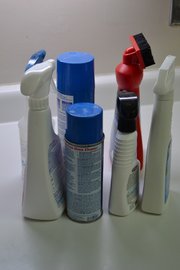Ophthalmologists are using the month of October, Eye Injury Prevention Month, to promote eye safety and raise awareness about eye injuries. Photo by Marilyn Campbell.
"Unfortunately, most people don’t think about eye protection for home projects until it is too late."
— Dr. Lynn Polonski, ophthalmologist and spokesman for the American Academy of Ophthalmology
Nancy Mahon was cleaning the bathroom of her Herndon home last spring when she noticed that something was going wrong.
"My eyes started burning intensely," she said. "They were red and felt like they were on fire." The source of her eye irritation was a chemical that she was using to clean her bathroom. She sought medical care and now uses mild, non-toxic cleaners.
Ophthalmologists, Optometrists and Opticians: Understanding the Role of Each
An ophthalmologist is a medical or osteopathic doctor who specializes in eye and vision care. Ophthalmologists differ from optometrists and opticians in their levels of training and in what they can diagnose and treat.
Optometrists are health care professionals who provide primary vision care ranging from sight testing and correction to the diagnosis, treatment, and management of vision changes. An optometrist is not a medical doctor
Opticians are technicians trained to design, verify and fit eyeglass lenses and frames, contact lenses, and other devices to correct eyesight.
Source: The American Academy of Ophthalmology
Simple tasks like gardening or cleaning can lead to eye injury, so ophthalmologists are using the month of October, Eye Injury Prevention Month, to promote eye safety and raise awareness about eye injuries.
"Unfortunately, most people don’t think about eye protection for home projects until it is too late," Dr. Lynn Polonski, M.D., an ophthalmologist and spokesman for the American Academy of Ophthalmology, said in a statement.
Experts say there are a few simple things that homeowners can do to decrease their risk of eye injury.
"Wear protective eyewear during risky activities, such as anytime you might be exposed to flying particles or dust. Wear goggles when exposed to chemicals," said Dr. Jean Glossa, medical director for the Fairfax County Community Health Care Network. "Take caution with chemicals and cleaners. Carefully read the labels of chemicals in household cleaning supplies and don’t mix products."
Glossa added that washing one’s hands after using chemicals is another preventative measure.
Children are also susceptible to eye injuries, but parents can take a few precautions to thwart harm.
"Avoid certain children’s toys [like] projectile toys such as darts and bows and arrows," said Glossa. "Keep all household cleaning supplies that contain chemicals and sprays out of a child’s reach, and cushion the sharp corners and edges of furniture and home fixtures."
The American Academy of Ophthalmology also recommends being careful when using lawn mowers, trimmers and shovels, which can propel dirt and debris into the air.

